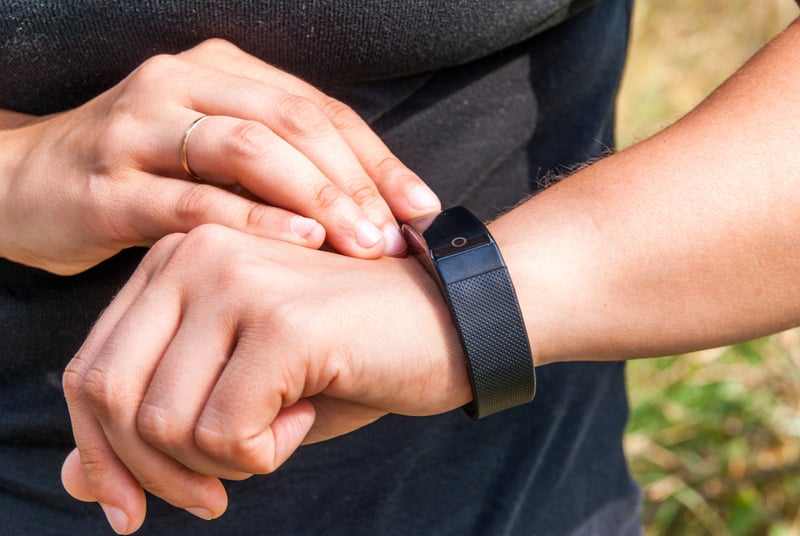Debunking the Myth: 10,000 Steps a Day is Best For Your Health

According to the mission statement of one of the top fitness tracking companies, FitBit, the idea behind their product is “to help people lead healthier lives by empowering them with data, inspiration, and guidance.” Fitness tracking devices are big business, and according to research firm IDC, more than 100 million fitness devices that fit on your wrist like a watch will be sold across the globe by 2019. But, is their suggested 10,000 steps a day program best for your health?
Walking 10,000 steps a day is not an official recommendation from the Centers for Disease Control and Prevention. So, with the default setting on most of these devices being 10,000 steps per day, have you ever wondered where this number came from? Who decided that in order to maintain your health, body composition, fitness, and performance, you should aim to take 10,000 steps?
The origins of the 10,000 steps a day recommendation aren’t exactly scientific. Pedometers sold in Japan in the 1960s were marketed under the name “manpo-kei,” which translates to “10,000 steps meter,” said Catrine Tudor-Locke, director of the Walking Behavior Laboratory at Pennington Biomedical Research Center in Baton Rouge, LA. The idea resonated with people and gained popularity with Japanese walking groups, Tudor-Locke said.
The Truth About Walking 10,000 Steps a Day
Michael Mosley, a medical journalist with the BBC, conducted his own experiment. He gathered a small group of participants and provided each of them with activity monitors to not only monitor what they did, but also how vigorously they did it. They were divided into two groups. One was asked to hit the 10,000-step target—around five miles—in a day, while the other group was asked to do three sessions of “Active 10” or walking briskly for ten minutes—which adds up to around 1.5 miles or closer to 3,000 steps at a more vigorous pace.
The “Active 10” group actually did 30% more “moderate to vigorous physical activity” than the 10,000-step group, even though they moved for less time. So even though the “Active 10” group spent less time actually moving, they spent more time getting out of breath and increasing their heart rate.
There is evidence to support that leisurely walking for 10,000 steps a day is not as effective at reducing the health markers associated with cardiovascular disease, diabetes, and cancer as doing more moderately intense activity.
Dr. Ben Kelly, head of preventative medicine at Nuffield Health, suggests using a different method for making sure you are in tip-top shape. Kelly believes your goal should be to achieve 150 minutes a week of exercise to lower your risk of chronic disease and cardiovascular event.
One way to test yourself whether or not you should increase your physical activity is to measure your resting heart rate. If your resting heart rate is above 60 beats per minute, you may need to increase your physical activity.
I currently have a group of 150 participants competing in a 12-Week Shape Up Challenge. In an effort to increase the physical activity of the members, we decided to keep track of our steps for seven days. During these seven days, not only did the majority of the group increase their steps each day, but they were moving more than EVER before.
“The step challenge has brought me to new personal heights of exercise, even if I’m well back in the pack on step totals. That’s OK. The real contest is against myself, and frankly, I’m kicking my @$$!”
– Howard H.“Tonight I took my son to his weekly class. Normally when we get there early, I read while he plays on the playground. This time I walked many, many times around the path connecting the buildings. I kept going for over an hour!”
– Allison B.“The step challenge is changing my life. Today I took the handicap permit out of my car. I found a fit bit in a desk drawer. Have never worn it because I only walked when I had to. I’ve almost doubled my steps in one day. I initially thought I’d be lucky to hit 10,000 in one week. I now am rethinking this.”
– Pam M.
Bottom line: Wearable devices offer people a challenging goal they can strive toward and a simple-to-understand baseline roughly equivalent to the minimum suggested amount of exercise.
10,000 Steps a Day: Take-Home Notes
If you are someone who is generally sedentary and setting a goal for taking 10,000 steps a day is an increase to your regular physical activity, then I am all for it. If you are a relatively active adult who is already meeting and/or exceeding the recommended amount of exercise per day/week, then adding 10,000 steps to your routine may not be the most effective use of your time.
At the end of the day, any amount of activity you can do today that you didn’t do yesterday, you’ll likely benefit from. So, whether you’re going for 10,000 steps, Active 10, hitting the gym, or riding your bike after work, whatever it takes to get you off your butt and moving more is what is best for your health.







